Locker Room Sign Decorating Idea

Locker Room Design: 7 Essential Elements
Planning your locker room design can seem like a daunting and overwhelming task. Whether you are designing a locker room for a gym, fitness center, country club or school, the essential elements are the same.
Let's get started:
1. Locker Room Floor Layout
Maximum utilization of your locker room space WITHOUT jeopardizing comfort and usability is the main goal when planning your locker room layout. You need to ensure that there is a proper flow of traffic and the lockers and seating do not prevent your patrons from easily getting around the locker room. If your guests will be changing clothes in your locker room, the locker configurations should also allow for semi-private areas in both wet and dry areas, without limiting the ease of getting to each area.
Life Safety Exit— Make sure your configuration is laid out so anyone in the locker room (no matter what area they are in) will have unimpeded regress from the locker room. In other words, allow everyone an easy straight shot to the lighted emergency exit door.
Another thing to consider is handicap accessibility. In order to comply with the guidelines of the Americans with Disabilities Act (ADA) for accessibility and design, you must allow 48 inches of space around your accessible lockers. Check for updates to ADA guidelines to make sure your locker room layout is ADA compliant.
When you purchase lockers from a locker manufacturer, they should provide you with a detailed custom layout unique to your locker room space and requirements.
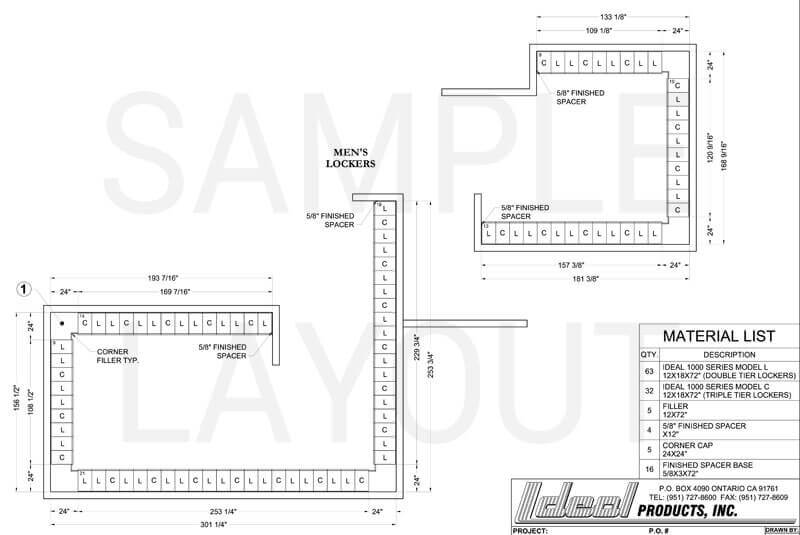
*Sample layout only. Layouts can also include peninsula and island configurations.
2. Locker Material
The type of material your lockers are made of is extremely important. You want durability to avoid the need for replacements. Other factors include cost, visual appeal, and resistance to humidity levels.
 Wood Lockers— Wood lockers are furniture quality and extremely durable. These work well for stadiums, athletics, sports teams, and upscale country clubs and gyms. You can opt for the raw natural wood look or choose from a number of stains, from cherry to maple, followed by premium glossy clear coats for a real classy finish. There is also the option to have the core of the locker be industrial grade particleboard with a wood veneer finish on the locker. The wood veneer provides the classiness of a solid wood locker, but is more economical.
Wood Lockers— Wood lockers are furniture quality and extremely durable. These work well for stadiums, athletics, sports teams, and upscale country clubs and gyms. You can opt for the raw natural wood look or choose from a number of stains, from cherry to maple, followed by premium glossy clear coats for a real classy finish. There is also the option to have the core of the locker be industrial grade particleboard with a wood veneer finish on the locker. The wood veneer provides the classiness of a solid wood locker, but is more economical.
 Plastic Lockers— Plastic lockers are very durable, economical and quiet. Plastic laminate lockers are another choice. There are many different types of material that plastic laminate lockers can be made from. The core of the locker can be made from Industrial Grade Particle Board, Medium-Density Fibreboard (MDF), or Thermal-Fused Melamine. Plastic laminate lockers work best for humid locker rooms, as they do not rust and are water resistant. Plastic is also extremely durable and resistant to scratches. Plastic laminate comes in two types of grades – vertical and horizontal. It is available in not just colored finishes, but also textured, glossy, matte, or a realistic wood grain. This is a very versatile locker material to suit many industries.
Plastic Lockers— Plastic lockers are very durable, economical and quiet. Plastic laminate lockers are another choice. There are many different types of material that plastic laminate lockers can be made from. The core of the locker can be made from Industrial Grade Particle Board, Medium-Density Fibreboard (MDF), or Thermal-Fused Melamine. Plastic laminate lockers work best for humid locker rooms, as they do not rust and are water resistant. Plastic is also extremely durable and resistant to scratches. Plastic laminate comes in two types of grades – vertical and horizontal. It is available in not just colored finishes, but also textured, glossy, matte, or a realistic wood grain. This is a very versatile locker material to suit many industries.
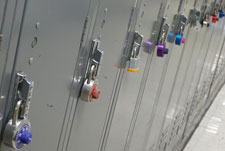 Metal Lockers— Metal lockers account for the majority of locker sales in the U.S. These lockers are mass produced at an affordable price. Because they are massed produced, your only choice is usually pre-set dimensions and being left with fitting however many lockers possible based on the limited dimensions offered. Metal lockers typically arrive at the job site KD (knocked down), meaning you receive a pallet full of parts and a huge bag of nuts and bolts. With metal lockers there is the cost of the materials, freight, jobsite assembly and installation to consider when planning your locker room budget. Other complaints include that they are noisy when opening and shutting the locker doors (which can be bothersome and real turn-off to your customers), and the color options are not as abundant as wood or plastic lockers. These reasons are why you will find most major metal locker manufacturers have also started to offer more color choices and manufacture wood and/or plastic lockers to suit their clients' needs.
Metal Lockers— Metal lockers account for the majority of locker sales in the U.S. These lockers are mass produced at an affordable price. Because they are massed produced, your only choice is usually pre-set dimensions and being left with fitting however many lockers possible based on the limited dimensions offered. Metal lockers typically arrive at the job site KD (knocked down), meaning you receive a pallet full of parts and a huge bag of nuts and bolts. With metal lockers there is the cost of the materials, freight, jobsite assembly and installation to consider when planning your locker room budget. Other complaints include that they are noisy when opening and shutting the locker doors (which can be bothersome and real turn-off to your customers), and the color options are not as abundant as wood or plastic lockers. These reasons are why you will find most major metal locker manufacturers have also started to offer more color choices and manufacture wood and/or plastic lockers to suit their clients' needs.
3. Locker Color/Finish
The color scheme of your locker room should match your brand. When you purchase pre-made lockers, chances are they will not match your specific branded colors. You need custom lockers that will tell people they are still in your facility when entering your locker room. Your locker room should not seem like an afterthought for your facility design, and should match your branding.
The finish of your lockers should also match the environment that your brand reflects. A dark, glossy wood finish works well for showcasing classy elegance for country clubs, whereas a light, natural wood finish works well for university and college sports lockers, and colored plastic laminate finishes could represent a fitness center better.
4. Fire Safety
The most common fire test for locker room materials (and all building materials) is The American Society for Testing and Materials (ASTM) Test Method E-84, which determines the flame-spread of the material. This test is also known as the tunnel test. The lower the flame-spread rating (FSR), the more fire retardant the material.
The FSR is classified into 3 categories:
- Class I or A are materials with a 0-25 FSR
- Class II or B are materials with a 26-75 FSR
- Class III or C are materials with a 76-200 FSR
For example, our Dura-FR Series plastic laminate lockers are rated a Class I-A because the flame spread rating is 25. When purchasing lockers or locker room benches, it's important to know the FSR of the product materials.
5. Locker Style & Size
First, analyze your demographics of your client base and what people will need to store in your lockers. For example, if your facility is located in a downtown area then most likely your users will require full length hanging space (42") for suits, jackets, skirts, pants, etc. If the facility is located near a university and members are expect to arrive on bicycles with back packs, then storage space rather than hanging space is important.
If your facility is a health or fitness club, we are finding today that some customers will arrive already dressed for their work-out and do not need to use the locker room. For these individuals, lockers located outside the locker room in a public area are very well suited. A facility should have a mixture of locker sizes based on the demographic analysis. This way you can accommodate all the needs of your client base.
The number of guests who will be using your facility is also essential to consider. You want to have enough lockers, but not sacrifice the size of the locker space each person gets if larger ones are needed. You also want to avoid cramming as many lockers in as possible and ruining the locker room layout.
There are A LOT of locker configurations to choose from: cell phone lockers, shoe lockers, lockers with built in benches, lockers with drawers, and Z-lockers for hanging shirts within a double tier, just to name a few.
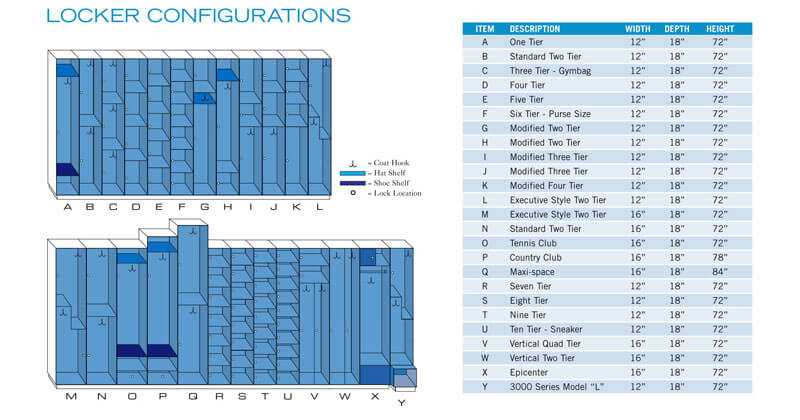
Don't forget to have handicap accessible lockers installed that comply with the ADA! 5% of your lockers must be ADA compliant. ADA compliant lockers are no more than 15 inches off the floor, have a surrounding clear floor space of 30″x48″ minimum, and storage spaces (shelves, coat hangers, etc.) are located at a height of 9″ minimum and 48″ maximum from the finished floor.
6. Locker Security
In order to determine the best type of locks for your facility, consider the following:
- Security vs. Convenience
- Permanent vs. Temporary
Security vs. Convenience
If maximum security is your main concern, the best (and most secure choice) for lockers are padlock hasp locks.
If convenience is also important to you, keyless lock options are a great choice. Your customers will not have to worry about padlocks or keys to gain access to the locker.
Permanent vs. Temporary
What are your lockers intended use? Will your lockers be issued to users for permanent or temporary use?
Permanent use means the individual stores their personal belongings in the locker and returns to this locker regularly.
Permanent locker lock solutions include padlock hasp locks, pushbutton combination locks, RFID locks, card reader locks, to name a few.
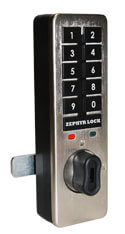
Temporary use means that a person selects an unused locker, secures their belongings for a limited period of time, and then removes their items and vacates the locker. Another person can then re-use this locker. Temporary lockers can have multi-user locks, where a combination is set by one person for one-time only. Once they are done with the locker, the next person can set their combo and use the same locker while keeping their items secure. This works especially well if your staff is stretched for time and you do not want to take up their time to individually assign lockers or hand out and collect keys.
Temporary locker lock solutions include multi-user combination locks, user programmable pushbutton locks, and user programmable keypad locks.
For your handicap accessible lockers, you will need a different lock solution. The ADA requires locks to be operable with one hand, not require tight grasping, pinching or twisting of the wrist to operate, and cannot require a force of more than 5lb to activate or operate.
7. Locker Room Seating & Amenities
Your locker room seating and amenities will add comfort and functionality to your locker room. You can choose from solid natural wood benches, metal stools with wood tops, plastic laminate seats, and more. It's important that your locker room seating matches or compliments your lockers. You must also have at least 1 ADA compliant locker room bench.
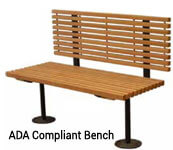
The ADA Accessibility Guideline 4.37 states that:
- Benches shall have back support that is 42 inches (1065 mm) minimum in length and that extends from a point 2 inches (51 mm) maximum above the seat to a point 18 inches (455 mm) minimum above the seat
- Benches shall be fixed and shall have seats that are 20 inches (510 mm) minimum to 24 inches (610 mm) maximum in depth and 42 inches (1065 mm) minimum in length.
- A minimum of 30" clear floor or ground space shall be provided and shall be positioned for parallel approach to a short end of a bench seat.
Grooming stations are also an added bonus to your guests. With a mirror and lighting, it's perfect to fix hair and get cleaned up after a shower or work out. It also provides additional storage space within your locker room.
Share these locker room design tips:
Locker Room Sign Decorating Idea
Source: https://www.idealockers.com/tech-info/locker-room-design/
Posted by: hornupout1979.blogspot.com

0 Response to "Locker Room Sign Decorating Idea"
Post a Comment